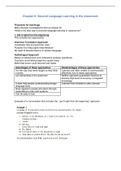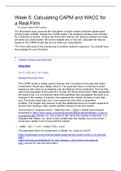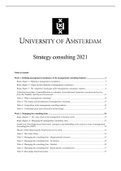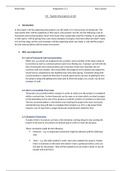Chapter 6: Second Language Learning in the classroom
Proposals for teachings
Many theories investigated to find an answer for
‘What is the best way to promote language learning in classrooms?’
1. Get it right from the beginning
This includes two approaches:
Grammar Translation Approach
Vocabulary lists and grammar rules
Purpose is to help pupils read literature
No need to develop fluency in spoken language
Audiolingual Approach
Based on behaviorism and contrastive analysis hypothesis
Teachers avoid letting beginners speak freely
Belief that errors could become bad habits
Advantages of these approaches Disadvantages of these approaches
It is the way they were taught so they think Learners are often unable to communicate
it works. effectively due to these approaches
Les demanding in the classroom Neither approach guarantees learners to
develop high level of accuracy or linguistic
knowledge.
It does help people understanding foreign Learners feel inhibited to take chances
language texts.
Does appeal to people who learn through
responding to rules and systems.
Can be easy to test.
Example of a conversation that includes the ‘’get it right from the beginning’’ approach.
, 2. Just listen ... and read
Emphasis is on providing comprehensible input through listening and/or reading activities.
Research findings
o Listening and reading strategies can lead to a better understanding
o Reading enhances vocabulary skills
o input floods allow for high-frequency exposure to grammatical forms
Interpreting the research
o comprehension-based learning is an excellent way to begin learning and is a good
supplement.
o input-based instruction is effective in guided learning and listening/reading for
meaning.
3. ‘’Let’s talk’’, also known as: Communicative approach
o Comprehensible Input and conversational interactions
o Negotiating for meaning
o Arrive at mutual understanding
o Work together to accomplish a particular goal
Characteristics of communicative approach:
o Competence based
o Pair and group work
o Learners oriented
o 4 skills integrated
o Themes and topics
o Meaningful and authentic language in realistic situations
Characteristics of communicative approach:
o Content over form (correctness less important than the message as long as
communication is not difficult)
o Cyclic- repetitions with new structures
o Communication of meaning in interaction rather than practice and manipulation of
grammatical forms in isolation
o Functional/notional approach
Activities in communicative approach:
o Interviews
o Guessing games
o Questioning activities
o Problem solving
o Discussion
o Roleplays
Example of a conversation using the communicative approach:
Proposals for teachings
Many theories investigated to find an answer for
‘What is the best way to promote language learning in classrooms?’
1. Get it right from the beginning
This includes two approaches:
Grammar Translation Approach
Vocabulary lists and grammar rules
Purpose is to help pupils read literature
No need to develop fluency in spoken language
Audiolingual Approach
Based on behaviorism and contrastive analysis hypothesis
Teachers avoid letting beginners speak freely
Belief that errors could become bad habits
Advantages of these approaches Disadvantages of these approaches
It is the way they were taught so they think Learners are often unable to communicate
it works. effectively due to these approaches
Les demanding in the classroom Neither approach guarantees learners to
develop high level of accuracy or linguistic
knowledge.
It does help people understanding foreign Learners feel inhibited to take chances
language texts.
Does appeal to people who learn through
responding to rules and systems.
Can be easy to test.
Example of a conversation that includes the ‘’get it right from the beginning’’ approach.
, 2. Just listen ... and read
Emphasis is on providing comprehensible input through listening and/or reading activities.
Research findings
o Listening and reading strategies can lead to a better understanding
o Reading enhances vocabulary skills
o input floods allow for high-frequency exposure to grammatical forms
Interpreting the research
o comprehension-based learning is an excellent way to begin learning and is a good
supplement.
o input-based instruction is effective in guided learning and listening/reading for
meaning.
3. ‘’Let’s talk’’, also known as: Communicative approach
o Comprehensible Input and conversational interactions
o Negotiating for meaning
o Arrive at mutual understanding
o Work together to accomplish a particular goal
Characteristics of communicative approach:
o Competence based
o Pair and group work
o Learners oriented
o 4 skills integrated
o Themes and topics
o Meaningful and authentic language in realistic situations
Characteristics of communicative approach:
o Content over form (correctness less important than the message as long as
communication is not difficult)
o Cyclic- repetitions with new structures
o Communication of meaning in interaction rather than practice and manipulation of
grammatical forms in isolation
o Functional/notional approach
Activities in communicative approach:
o Interviews
o Guessing games
o Questioning activities
o Problem solving
o Discussion
o Roleplays
Example of a conversation using the communicative approach:









